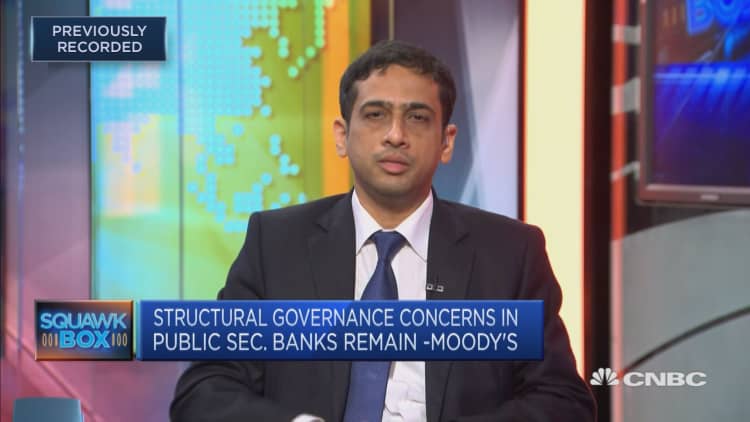India's largest lender posted its first quarterly loss in 17 years for the three months ended in December, but its chairman told CNBC that the rest of the year looks much better.
The State Bank of India reported a net loss of 24.16 billion rupees ($361.8 million) for the December quarter, compared with a profit of 18.20 billion rupees ($272.5 million) a year earlier. The bank blamed lower trading income from higher bond yields, higher loan loss provisions and significant investment depreciation for the loss.
"Two factors are impacting our profit. Loan loss provision takes the large chunk," Rajnish Kumar, chairman of SBI, told CNBC's Oriel Morrison in Manila, the Philippines, on Friday. "Dictated costs are very, very elevated and not affordable."
Loan loss provisions are counted as expenses that are set aside as allowance for uncollected loans and loan payments.
SBI said its gross non-performing assets increased from 1.86 trillion rupees ($27.8 billion) in September to a staggering 1.99 trillion rupees ($29.8 billion) as of December.
"Last year, in terms of profits, in terms of asset quality, it was a big challenge," Kumar said. "But this year onward, we are expecting that we will be in a much better position and this year looks much, much better."
SBI will release its full fiscal 2018 earnings on May 22, according to Kumar. In India, the financial year usually starts on Apr 1.
Huge problems with bad debts for banks
Kumar's comments come in the midst of serious problems for India's banking sector.
Banks, which are a key source of funding for Indian companies, have struggled in recent years as bad debts have risen and instances of fraud have come to light.

Stressed loans from local banks came to about $146 billion at the end of June last year, according to reports. That included non-performing and restructured or rolled over loans.
The Reserve Bank of India's financial stability report said in December that large borrowers accounted for more than 80 percent of bad debt in portfolios of scheduled commercial banks in September — those include public sector and private sector Indian banks, regional rural banks and private foreign banks.
Public-sector banks wrote off bad loans worth 2.41 trillion rupees ($36 billion) between April 2014 and September 2017, according to local reports that cited government sources. Banks usually write off bad debts or non-performing assets to clean up their balance sheets
Short-term pain ahead
This week, Moody's Investors Service said that an ongoing Reserve Bank of India push to make local banks accurately recognize bad assets will reduce near-term profits in the sector. But there will be benefits over the long term, the ratings agency said.
The Reserve Bank of India tightened guidelines for banks to resolve bad assets in February. Under the new rules, banks can't use loan restructuring schemes to delay recognizing bad debt.
"The Reserve Bank of India's rules are credit positive because they provide a clearer, time-bound process for resolving stressed assets and will prevent a future buildup of problem loans in the system," Alka Anbarasu, vice president and senior analyst at Moody's Investor Service, said in a note.
Banks have recognized many loans as bad assets since 2015, Moody's said. But the banks still hold many restructured loans that will go bad in the coming quarters, according to the ratings agency.
"For every delinquent loan, banks now must implement a resolution plan within 180 days of the initial default," analysts at Moody's said. "If a bank fails to implement a resolution plan in time, it must refer that asset for insolvency proceedings."
Moody's added that as banks reclassify those assets, non-performing loan ratios will gradually rise. But once the process is complete, they will stabilize and eventually decline.
— Reuters contributed to this report.
Correction: This report has been updated to reflect a proper conversion of 18.20 billion rupees into $272.5 million.


